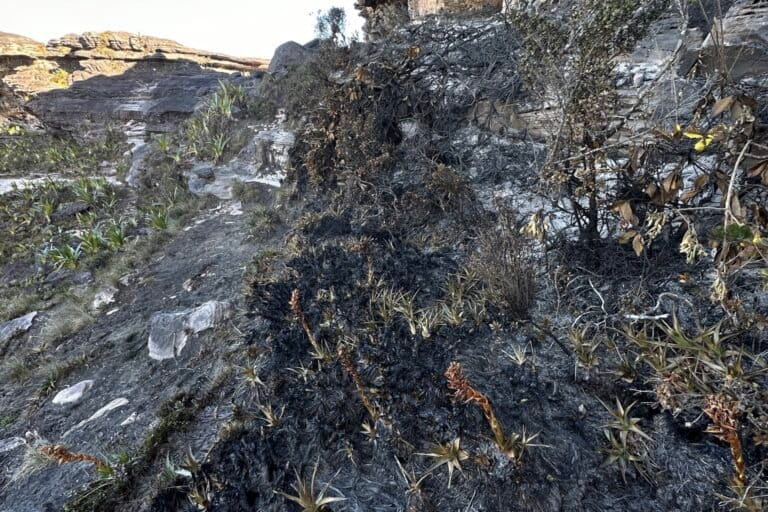- A fire on the top of Mount Roraima in Venezuela has baffled scientists, park guards and local community leaders, who have never seen a fire in the area and worry that the rare mountain ecosystem could face increasing threats.
- A photography expedition encountered a mysterious fire that may have been manmade, a lightning strike — or something much more spectacular.
- More resources are needed to educate tourists and locals about the tepuy ecosystem, as well as to monitor human behavior there, experts said.
A strange fire on the top of a unique geological formation in Venezuela has baffled scientists, park guards and local community leaders, who have never seen a fire in the area and worry that the rare mountain ecosystem could face increasing threats in the future.
The fire took place in May at the summit of a famous table-top mountain (known locally as a “tepuy”) called Mount Roraima, which sits on the border of Venezuela, Brazil and Guyana. The tepuy is approximately 2,723 meters (8,933 feet) high with a summit that stretches around 34 square kilometers (13 square miles). Its ecosystem is full of endemic species that have yet to be thoroughly studied.
During a photography expedition, Silesian researcher and photographer Mateusz Wrazidlo was hiking the tepuy in Venezuela’s Canaima National Park when he and his team stumbled upon the smoldering remains of the fire, which looked to cover roughly 160 square meters (around 1,722 square feet).
Wrazidlo and the guides were shocked to see a fire there, let alone one so big, since the tepuy is normally a cool, wet environment with frequent fog and humidity. There also weren’t any obvious clues about what might have started it. Fires are known to happen on the bottom of the mountain, but there’s no way for them to spread up the steep cliffs to the summit.
“Given the [climate] conditions, it’s unlikely that a natural fire occurred there,” said Lionel Hernández, a retired professor at the National Experimental University of Guyana (UNEG), who Wrazidlo and his team consulted later. “More likely is that it was manmade.”
Hernández has worked in the area for more than 40 years and said he’s never seen a fire on the top of a tepuy. He and Wrazidlo’s team couldn’t agree on the exact cause, or what it might mean for conservation in the area.


On the one hand, the tepuy receives tourists looking to hike and camp, so a lit cigarette or abandoned cooking site might have spread the flames. On the other hand, the fire wasn’t near designated camping spots that tourists frequent, only a trail, and there were no signs of hikers around the site when Wrazildo’s team arrived.
Canaima National Park has experienced an influx of illegal mining over the last several years, much of it overseen by criminal groups and the armed forces. That might have been a potential theory for the fire were it not for the fact that miners haven’t migrated to the summit yet, according to NGOs that weren’t associated with Wrazildo’s team.
Other theories include a lightning strike or even the reflection of the sun through naturally formed crystals, which could have acted like a magnifying glass against vegetation that was abnormally dry that day.
Regardless of the origin, a fire in such a remote, endemic peatland ecosystem is a cause for concern for researchers. Species there have been evolving and diversifying since the tepuy’s formation at the end of the Jurassic period, so they aren’t prepared for fires.

“If the frequency of fires were to increase, it would be devastating because there’s no tolerance among the species for these kinds of conditions,” said Judith Rosales, a Venezuelan researcher of the Guiana Shield and Orinoco.
As temperatures keep rising due to climate change, drying out the area, there may be additional fires on Mount Roraima — especially if human activity increases. Rosales said it will be important for the three countries that share the tepuy to increase their coordination and to provide more funding and resources to the area so it isn’t lost.
“If we don’t oversee the training of local communities, as well as undergraduates and doctoral researchers who participate in the conservation of these local environments, it will be very difficult to preserve the tepuys,” Rosales said.
Banner image: Mount Roraima in Venezuela. Photo courtesy of Mateusz Wrazidlo.
FEEDBACK: Use this form to send a message to the author of this post. If you want to post a public comment, you can do that at the bottom of the page.
See related from this reporter:
Venezuela’s environmental crisis is getting worse. Here are seven things to know.
